If you’ve just bought a hot tub or are about to purchase one, you’re probably wondering if it needs to be GFCI-protected. What are the electrical standards and codes for hot tubs and is it the same for portable, inflatable, swim spas and permanent hot tubs?
All types of hot tubs (inflatable or permanent) and swim spas must be GFCI protected by a Class A GFCI Personal Protection device as stated by the NEC (National Electrical Code) in Article 680. And all outlets located between 6 ft (3 m) and 20 ft (3.83 m) must also be GFCI protected.
There is a bit more to it than that, though. Let’s dig in and have a closer look.
Disclaimer: Please be aware that the laws and codes in your area may be different. The information in this article is provided solely for general interest and may not reflect legal requirements. Consult a qualified electrician in your local area for advice for your specific situation.
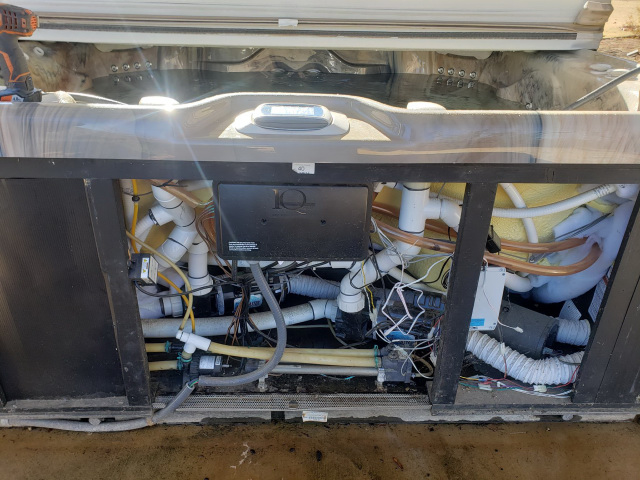
Article Contents
What is a GFCI for a Hot Tub?
A GFCI circuit breaker or ground-fault circuit interrupter is an electrical protection device that turns off the power should a fault in the electrical circuit occur.
The GFCI monitors the amount of current (electrical flow) going to the ground and if it detects a current imbalance (usually 4-6 milliamps or greater) it will cut off the power. Situations such as water splashing on an electrical component, a fault with a motor, and a person touching a live line can all cause a GFCI to trip.
Essentially, the GFCI is designed to turn off the power very quickly to prevent fatal electrocution. A current of 30 mA is enough to cause heart fibrillation, which can lead to cardiac arrest. A GFCI in a hot tub will switch the power off when the current is between 4 and 6 mA to prevent serious injury or death.
Electrical Codes & Regulations for Hot Tubs
We have summarized the GFCI requirements for hot tubs in this article. All of this information has been pulled from The National Electrical Code (NEC) or NFPA 70. You can find it in Article 680.
The NEC is the standard code in the USA from which 50 states create their own codes and electrical standards. In many cases, the NEC is followed as is, but there are variances in the codes and requirements from state to state. That’s why it’s important you check the GFCI requirements for hot tubs in your state too.
Related Reading: Swimming Pool & Spa Electrical Requirements in New York State
Do Outside Hot Tubs, Need a GFCI?
Hot tubs located outside require GFCI protection according to the National Electrical Code. This includes inflatable, portable, inground, and all other types of hot tubs, spas, and swim spas.
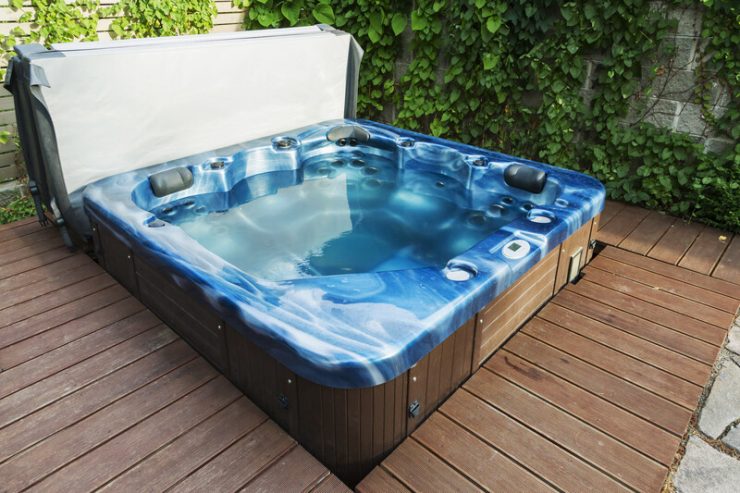
Outside Convenience Receptacles (Outlets)
Outlets and receptacles for hot tubs located outside need GFCI protection. GFCI protection is required for receptacles and convenience receptacles (outlets) as follows:
- Must be a Class A type (trips at between 4 and 6 mA)
- Are located less than 20 ft (6 m) from the inside walls of the hot tub
- Receptacles must be a minimum distance of 6 ft (1.83 m) from the inside walls of the hot tub or spa
- You must have a minimum of one outlet located between 6 and 10 feet from the hot tub.
- Receptacles should be installed no higher than 6 ft 6 inches (1.83 m) above the surface of the water.
- Outlets need to have a waterproof covering
Do Indoor Hot Tubs Need a GFCI?
All indoor hot tubs swim spas and the like require GFCI protection. This applies to inflatable, portable, and permanently installed hot tubs.
Receptacles (Outlets) for Indoor Hot Tubs
The NEC asks for the following requirements for indoor hot tubs:
- At least one general-purpose receptacle is to be installed between 6 ft (1.83 m) and 10 ft (3 m) from the hot tub.
- All receptacles on a 125V circuit 30 amps or less require GFCI protection if located within 10 ft (3 m) of the hot tub.
GFCI Type for Indoor Hot Tubs
Indoor hot tubs require the following type of GFCI:
- Must be a Class A type (trips at between 4 and 6 mA)
- Self-contained (portable), circuit breaker, or receptacle type GFCI are acceptable
Do Inflatable or Portable Hot Tubs Need GFCI?
Inflatable and portable hot tubs must be protected by a GFCI according to the National Electrical Code in Part III Section 680.32. These hot tubs are classified by the NEC as storable spas or storable hot tubs.
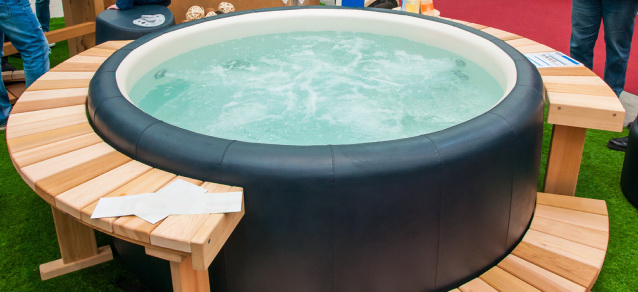
Here’s the exact wording:
“All electrical equipment, including power-supply cords, used with storable pools shall be protected by GFCI.”
The NEC (National Electrical Code) Article 680.32
Convenience Receptacles (Outlets) & GFCI Protection
GFCI protection is required for receptacles and convenience receptacles (outlets) if:
- The receptacle is on a 125V circuit
- Is 15 or 20 amp
- Located less than 20 ft (6 m) from the inside walls of the hot tub
This means all main electrical outlets must be GFCI protected. Outlets must also be a minimum of 6 ft (1.83 m) from the inside walls of the hot tub or spa.
GFCI Type for Inflatable Hot Tubs
There are many different types of GFCI on the market.
Here’s the type of GFCI you need for inflatable and portable hot tubs:
- Self-contained (portable), circuit breaker, or receptacle type GFCI are acceptable
- Must be Personal Protection Class A (6 mA type)
- Must protect all receptacles or power cords and equipment
Do Plug-In Hot Tubs Need a GFCI?
Plug-in (cord and plug) hot tubs require GFCI protection as per section 680.42 (2) of the National Electrical Code.
Plug and play hot tubs need the following GFCI type:
- Self-contained (portable), circuit breaker, or receptacle type GFCI are acceptable
- Must be Personal Protection Class A (6 mA type)
- Must protect all receptacles or power cords
What Type of GFCI Can Hot Tubs Use?
As per the National Electrical Code, hot tubs must use the following types of GFCI to meet the code:
- A Class A Personal Protection GFCI
- Receptacle GFCI, portable or GFCI located in the breaker board panel
A Class A GFCI (ground-fault circuit interrupter) will turn off the power between 4 mA and 6 mA. Class A GFCIs are more sensitive than the regular GFCI used in other areas of the home.
There are a few different types of GFCI that are acceptable for hot tubs. These are:
- Breaker Board GFCI
- Receptacle GFCI
- Portable or self-contained GFCI
A breaker board mounted GFCI or panel GFCI is installed directly in the electrical panel. This type of GFCI protects all the wiring from the board and also equipment. It is the most comprehensive GFCI type because it protects everything.
Receptacle GFCIs are built into the power outlet (receptacle) itself. The lines (cables) between the breaker board and the outlet are not protected. The outlet itself and any cords or equipment plugged into this are protected.
A portable GFCI is a self-contained unit that can be plugged into a normal outlet. This unit will protect the equipment plugged into it. It does not protect the receptacle or the wires between the receptacle to the breaker board.
Keep in mind that if the outlet you plug your portable GFCI into is located within 20 ft (6 m) from the hot tub’s edge, this outlet must be GFCI protected. Either a receptacle GFCI or a panel mounted.
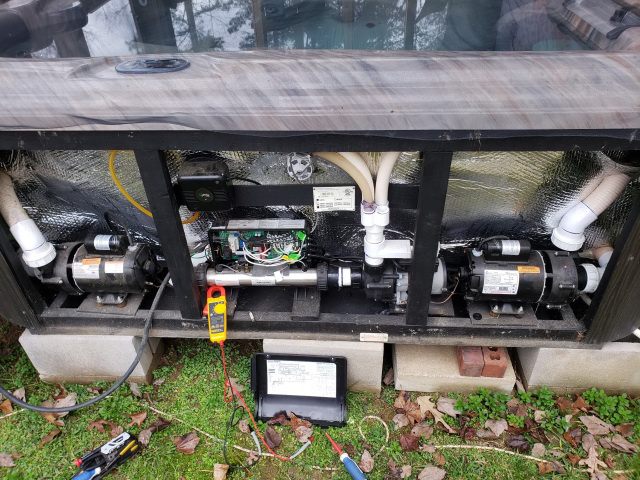
How Much Does it Cost to Install a GFCI?
The cost to install a GFCI for a hot tub varies between $15 for DIY jobs and $140 to $1100 for an electrician to do the work.
If you hire an electrician and you only need a new GFCI outlet or GFCI breaker swapped, it could cost $140 to $310.The cost of the GFCI receptacle or DIN mount (panel mount) circuit breaker is only $15 to $50. The labor cost will vary from $80 to $150 per hour.
If the electrician needs to run new cables and/or install a dedicated circuit, then the costs are higher. You’re looking at $510 to $1100 to run a GFCI-protected dedicated and wires for a hot tub.
The cost is mostly labor and will depend on the difficulty to run the wires.
For example, if your hot tub is located a long way from your house breaker panel and the cables are to be run underground, the cost will be on the higher end as trenches will need to be dug, conduit installed and a longer cable length is required.
Related Reading: How to Fix Pool Pump Tripping Circuit Breaker (Repeatedly)
How Far Should a GFCI be From a Hot Tub?
GFC-protected outlets should be located within 6-10 ft of your hot tub. Hot tubs are only allowed to come with cords that are shorter than 15 ft (4.6 m), as per section 680.42 (A)(2), the outlet needs to be close enough for the cord to reach.
For indoor hot tubs, at least one GFCI-protected convenience outlet or receptacle must be installed within 6-10 ft of your hot tub as per the National Electrical Code (Section 680).
The GFCI can be a receptacle type or a panel mounted (breaker board) type and must be a Class A type.
What Size GFCI Do Hot Tubs Need?
Plug and play (non-permanently installed) hot tubs using 120 V circuits require a 20 amp GFCI breaker or receptacle. For 230 or 240 V tubs and spas, the GFCI breaker size should be 40 to 60 amp in most cases.
The exact current rating needed for the GFCI will depend on the electrical requirements of your hot tub’s heater and motors. Consult a qualified electrician for advice.
Exceptions to Hot Tub GFCI Requirements
There is an exception for a hot tub requiring a GFCI. Low-voltage motors where it’s not necessary to ground them, and with ratings that are below the low-voltage limit and are supplied with an approved power supply, do not require GFCI protection.
The power supply or transformer used must be listed, labeled, and identified for pool and spa use.
However, if the outlet the power supply or transformer plugs into is located within 20 ft (6 m) of the inside wall of the hot tub, inflatable hot tub, or spa, a GFCI is required.
In reality, most hot tubs will not meet the rules for this exception.
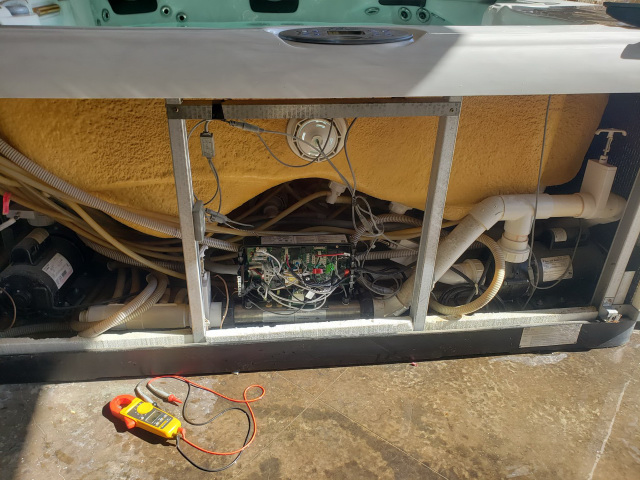
Other Wiring Requirements
- For indoor tubs, an emergency stop switch or disconnect needs to be installed within 5 ft (1.5 m) of the tub. This should shut off circulation and jet pumps and be within sight.
- A dedicated outlet and circuit are required.
- Circuit wires must be #12 AWG or larger (more likely #6 AWG or #8 AWG).
Related Reading: What Gauge or Thickness Wire Does a Pool Pump Need?

